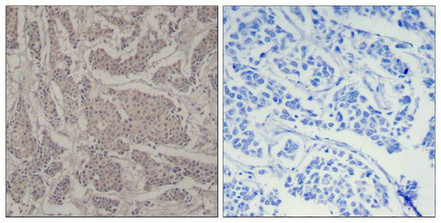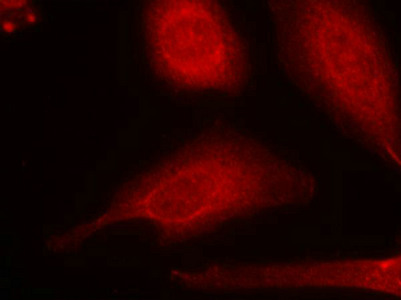
Immunohistochemical analysis of paraffin-embedded human breast carcinoma tissue using Smad3(Ab-425) Antibody(left) or the same antibody preincubated with blocking peptide(right).
SMAD3 (Ab-425) Antibody
CSB-PA794085
ApplicationsImmunoFluorescence, ELISA, ImmunoHistoChemistry
Product group Antibodies
ReactivityHuman, Mouse, Rat
TargetSMAD3
Overview
- SupplierCusabio
- Product NameSMAD3 (Ab-425) Antibody
- Delivery Days Customer20
- ApplicationsImmunoFluorescence, ELISA, ImmunoHistoChemistry
- CertificationResearch Use Only
- ClonalityPolyclonal
- ConjugateUnconjugated
- Gene ID4088
- Target nameSMAD3
- Target descriptionSMAD family member 3
- Target synonymshMAD-3; hSMAD3; HSPC193; HsT17436; JV15-2; LDS1C; LDS3; MAD homolog 3; mad homolog JV15-2; mad protein homolog; MAD, mothers against decapentaplegic homolog 3; mad3; MADH3; mothers against decapentaplegic homolog 3; mothers against DPP homolog 3; SMA- and MAD-related protein 3; SMAD, mothers against DPP homolog 3
- HostRabbit
- IsotypeIgG
- Protein IDP84022
- Protein NameMothers against decapentaplegic homolog 3
- Scientific DescriptionSmad3 encoded by this gene belongs to the SMAD, a family of proteins similar to the gene products of the Drosophila gene mothers against decapentaplegic (Mad) and the C. elegans gene Sma. SMAD proteins are signal transducers and transcriptional modulators that mediate multiple signaling pathways. This protein functions as a transcriptional modulator activated by transforming growth factor-beta and is thought to play a role in the regulation of carcinogenesis. Shi W, et al. J Cell Sci. 2007 Apr 1;120(Pt 7):1216-24 Seong HA, et al. J Biol Chem. 2007 Apr 20;282(16):12272-89 Wordinger RJ, et al. Invest Ophthalmol Vis Sci. 2007 Mar;48(3):1191-200 LeClair RJ, et al. Circ Res. 2007 Mar 30;100(6):826-33
- ReactivityHuman, Mouse, Rat
- Storage Instruction-20°C or -80°C
- UNSPSC12352203

